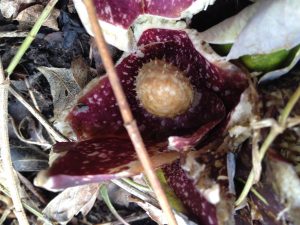
Ohio’s heat-generating wildflower is in bloom, signaling that spring isn’t that far off.
One of the first wildflowers to appear each year, skunk cabbage (Symplocarpus foetidus) has been showing its colors for several weeks in wet, marshy woodlands of central Ohio.
Besides its early bloom time, one of the plant’s most unusual characteristics is its ability to defy frigid weather.
The National Wildlife Federation says its flower buds can warm up to 70 degrees to melt snow around the plant.
Indeed photos often show the red-and-green mottled spathes surrounded by ice.
The spathes rise from the mire only a few inches to curl protectively around a yellow spadix. The petal-less flowers of the spadix attract flies and beetles to spread their pollen. After the bloom fades, tropical-looking leaves appear, although they don’t last long in the wet areas where the plant thrives.
Until this week, I’d seen only photos of this plant, a member of the arum family. Although I’ve wanted to see it, I’ve never had time to go exploring woodlands during the short days of February before.
But armed with great directions from naturalist Jim McCormac, I found my quarry at Kiwanis Riverway Park. (In fact, finding the skunk cabbage was far easier than finding the poorly marked park.)
Skunk cabbage can be seen along both sides of the boardwalk at the small park, 6245 Riverside Drive, Dublin. It also can be seen a bit off trail, at the end of a well-worn path. But be sure to watch where you step if you go off-trail. Although not fully camouflaged, skunk cabbages blend into the winter landscape.
The park makes for a nice walk, although it’s a testament to the evils of Asian honeysuckle and privet, both of which run rampant in the park. Still, I saw a number of interesting birds, including a bluebird, during my walk there.
Besides skunk cabbage, a few other flowers are signaling the coming of spring.

Witch hazel, a yellow-flowered shrub native to the state, has been sighted, as have exotic snowdrops and winter aconite.
Spring arrives March 20.
And now I’ll make a pitch to nature lovers everywhere: If you enjoy nature, you should follow Jim McCormac’s blog, jimmccormac.blogspot.com. Jim always points out interesting finds, accompanied by tremendous photos.
Conclusion: A walk in the woods is never wasted.
